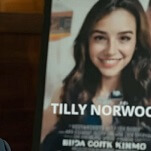The auteur theory was designed to recognize the covert artistry of Hollywood directors like Howard Hawks and Nicholas Ray, whose work on programmatic studio fare was unified by recurring themes and signature camera angles. But some studio-era auteurs were flashier with their style and more open with their obsessions—like Fritz Lang, whose thrillers explored human guilt and the myriad ways that overconfident people fail to see the implications of their actions. Though he came out of German Expressionism, Lang eventually refined his mise-en-scene to the point where he could articulate a character's interior state with a single shot.
In Lang's 1945 noir Scarlet Street, that shot comes early. Edward G. Robinson plays a hen-pecked husband and go-nowhere company man who leaves a party at his boss' mansion and walks through a trash-strewn city until he spies pimp Dan Duryea beating up one of his girls, Joan Bennett. Robinson intervenes and knocks Duryea flat, and Lang dwells for a moment on the look of unexpected pleasure on Robinson's face. That look says everything about Robinson's meekness and capacity for violence, and it explains what happens next: Bennett conning Robinson into embezzling money, Duryea convincing hobbyist painter Robinson to sell his artwork under Bennett's name, and, of course, the inevitable stabbing.
Scarlet Street has previously been available on DVD in appallingly fuzzy public-domain editions, but Kino's new disc uses the restored Library Of Congress print and adds a commentary track by Lang expert David Kalat, who provided the immensely entertaining commentary for Criterion's The Testament Of Dr. Mabuse. Kalat doesn't disappoint this time either. He explains the differences between Scarlet Street and Jean Renoir's more comic 1931 take on the same material, La Chienne, and he also offers historical perspective, funny Lang anecdotes, lively opinions, and suggestions for a Fritz Lang drinking game. (Take a shot when you see one of the following: a woman in a nightgown, an angry mob, a wrongful execution, and so on.)
Kino's Scarlet Street DVD is matched in significance by the simultaneous release of House By The River, a beautiful and brutish 1950 Lang noir that has been barely seen outside of the occasional retrospective. The film opens with idle aristocrat Louis Hayward accidentally strangling his maid to death while preventing her from alerting the neighbors to his sexual advances. Hayward's hobbled, soft-hearted brother Lee Bowman helps him get rid of the body, and when evidence turns up that implicates Bowman, the weasely Hayward doesn't hesitate to encourage the accusation.
House By The River is ominous from the start, when Hayward watches a dead deer float past his opulent home, and the film moves quickly through its plot to a pulpy twist ending, while offering some unforgiving analysis of the upper-class' inability to accept responsibility. Lang often frames the action through tall, narrow windows that constrict and define the characters, but House By The River's most potent shot comes in the opening scene, when Hayward hears the maid's bathwater draining through the house's pipes and his eyes gleam with awful, all-too-human lust.








































